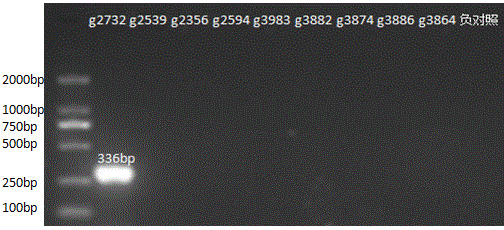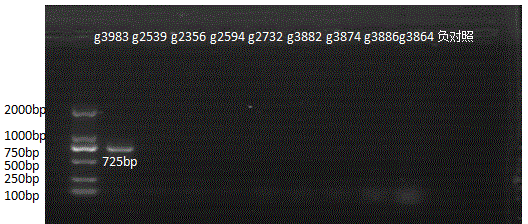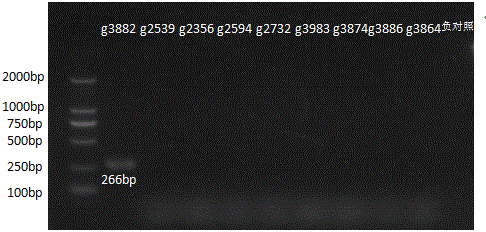Nucleotide specific to Cronobacter O antigen and application thereof
A Cronobacter and nucleotide technology, applied in the field of nucleotides, can solve problems such as poor accuracy, long time consumption, and insufficient quantity, and achieve the effects of easy industrial production, simple preparation method, and short detection cycle
- Summary
- Abstract
- Description
- Claims
- Application Information
AI Technical Summary
Problems solved by technology
Method used
Image
Examples
Embodiment 1
[0030] Genome extraction:
[0031] 37°C 2YT liquid medium (recipe: peptone 16g / L, yeast powder 10g / L, NaCl 5g / L) to culture Cronobacter, collect the bacteria, and extract the genome. The specific steps are as follows:
[0032] The cells were resuspended with 500ul 50mM Tris-HCl (pH8.0) and 10ul 0.4M EDTA, incubated at 37°C for 20 minutes, and then 10ul 10mg / ml lysozyme was added to continue the incubation for 20 minutes. Then add 3ul 20mg / ml proteinase K, 15ul 10% SDS, incubate at 50°C for 2 hours, then add 3ul 10mg / ml RNase, and incubate at 65°C for 30 minutes. Add an equal volume of phenol to extract the mixture, take the supernatant, and then extract twice with an equal volume of phenol: chloroform: isoamyl alcohol (25:24:1), take the supernatant, and then extract with an equal volume of ether. Extract to remove residual phenol. Precipitate DNA with 2 times the volume of ethanol in the supernatant, roll out the DNA with glass wool and wash the DNA with 70% ethanol, and fina...
Embodiment 2
[0034] O antigen gene cluster deciphered:
[0035] (1) The O antigen gene cluster of Cronobacter was amplified by Long-PCR. According to Genbank galF Gene design upstream primers, and then according to gnd Gene design downstream primers.
[0036] The PCR reaction program is as follows: pre-denaturation at 94°C for 5 minutes; then denaturation at 94°C for 30 seconds, annealing at 61°C for 30 seconds, and extension at 68°C for 15 minutes. This is done for 30 cycles. Finally, continue to extend at 68°C for 8 minutes to obtain PCR For the product, the size and specificity of the PCR product were detected by 0.8% agarose gel electrophoresis, 8 tubes of 50 μl long PCR product were combined, and the PCR product was purified with the Wizard PCR Preps purification kit from Promega.
[0037] Construction of the O antigen gene cluster library: The O antigen gene cluster library was constructed by the shot-gun method. The reaction system was 600ng of PCR purified products, which w...
Embodiment 3
[0041] Primer design and screening
[0042] According to the deciphering of gene clusters, we found that wzy / wzm It is indeed a specific gene of Cronobacter, so a specific segment of the gene is selected to design specific primers. The above-mentioned genes were introduced into Primer Premier 5 for primer design. The length of the primers should preferably be between 18-24 bp, and the Tm value should be between 50-55°C.
[0043] After the primers are designed, BLAST is performed in Genbank. The designed primers should not have too high sequence similarity with other related bacteria, so as to ensure that the primers can only amplify at their predetermined positions, and not with other related bacteria or bacteria. Relative bacteria in the environment where the specimen was collected did not produce a positive reaction. This point is very important to avoid the generation of non-specific bands and the success or failure of the experiment. The designed primers are shown in T...
PUM
 Login to View More
Login to View More Abstract
Description
Claims
Application Information
 Login to View More
Login to View More - R&D
- Intellectual Property
- Life Sciences
- Materials
- Tech Scout
- Unparalleled Data Quality
- Higher Quality Content
- 60% Fewer Hallucinations
Browse by: Latest US Patents, China's latest patents, Technical Efficacy Thesaurus, Application Domain, Technology Topic, Popular Technical Reports.
© 2025 PatSnap. All rights reserved.Legal|Privacy policy|Modern Slavery Act Transparency Statement|Sitemap|About US| Contact US: help@patsnap.com



